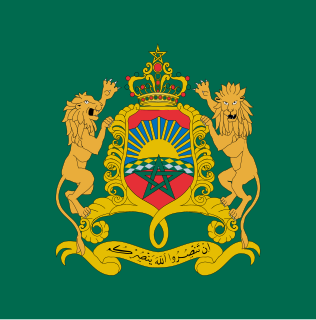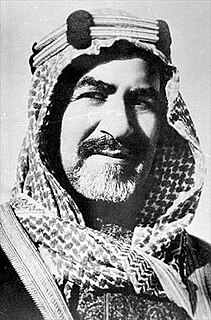This page is based on this
Wikipedia article Text is available under the
CC BY-SA 4.0 license; additional terms may apply.
Images, videos and audio are available under their respective licenses.

The Alaouite dynasty, or Alawite dynasty, is the current Moroccan royal family. The name Alaouite comes from the ‘Alī of ‘Alī ibn Abī Ṭālib, Muhammad's son-in-law and cousin, whose descendant Sharif ibn Ali became Prince of Tafilalt in 1631. His son Mulay Al-Rashid (1664–1672) was able to unite and pacify the country. The Alaouite family claim descent from the Islamic prophet, Muhammad, through his daughter Fāṭimah az-Zahrah and her husband ‘Alī ibn Abī Ṭālib.

Ahmad Sanjar was the Seljuq ruler of Khorasan from 1097 until in 1118 when he became the Sultan of the Seljuq Empire, which he ruled as until his death in 1157.
The Sharif of Mecca or Hejaz was the title of the leader of the Sharifate of Mecca, traditional steward of the holy cities of Mecca and Medina and the surrounding Hejaz. The term sharif means "noble" in Arabic and is used to describe the descendants of Prophet Muhammad's grandson al-Hassan ibn Ali.

The Saadi dynasty or Saadian dynasty was an Arab Moroccan dynasty, which ruled Morocco from 1549 to 1659.

Lower Yafa, Lower Yafa'i, or the Sultanate of Lower Yafa, was a state in the British Aden Protectorate.

Abul Amlak Sidi Muhammad as-Sharif ibn 'Ali was the prince of Tafilalt from 1631 to 1636. He was born before 9 November 1589 as the sixth son of 'Ali ibn Muhammad as-Sharif al-Marrakchi.
Other names or spellings of his name are, among others: Moulay Ali Cherif, Moulay Muhammad I, Moulay Mohammed I, Sharif Sultan Abul, Muhammad al-Sharif, etc.
He is considered to have been the founder of the Alaouite Dynasty of Morocco. He began to increase his power in the Tafilalt during the anarchy following the death of the Saadi ruler Ahmad al-Mansur and ruled that region from 1631 to 1636. He abdicated the throne of Tafilalt in 1636 in favour of his eldest of fifteen sons, Muhammad ibn Sharif.
Moroccan literature is a literature written in (Moroccan) Arabic, Berber, French or Spanish, particularly by people of Morocco, but also of Al-Andalus.
Zidan Abu Maali was the embattled Sultan of Morocco from 1603 to 1627, ruling only over the southern half of the country after his brother took the northern half and a Sanhaji rebel from Tafilalt marched on Marrakesh claiming to be the Mahdi. All of which exacerbated by a context of chaos that ensued a plague pandemic which left a third of the country dead, the end of the Anglo-Spanish war —which broke the Anglo-Dutch axis that Morocco was relying upon as a means of protection from Spain, and so caused the Spanish navy to resume devastating raids on the Moroccan coast— and the rebellion of one of his provincial governors who established his own independent republic between Azemmour and Salé. He was the son and appointed heir of Ahmad al-Mansur, and resided mostly in Safi where he became encircled after being driven out of Marrakesh and failed military campaigns against the rebellious brother in the north.
Ahmad ibn al-Qadi or Ibn al-Qadi,(December 18, 1552 – December 6, 1616), fully Shihab al-Din abu l-‘Abbas Ahmad ibn Mohammed ibn Mohammed ibn Ahmed ibn Ali ibn 'Abd er-Rahman ibn Abi'l-' Afiyya el-Miknasi ez-Zanati, was the leading writer from Ahmad al-Mansur's court in Morocco next to Abd al-Aziz al-Fishtali. He was also a renowned judge and mathematician.
Shihab al-Din may refer to:
Nizam al-Din, spelled variously Nizamuddin or Nizamüddin or etc. may refer to:
Abdul Jabbar is a Muslim male given name, and in modern usage, surname. It is built from the Arabic words Abd, al- and Jabbar. The name means "servant of the All-compeller", Al-Jabbar being one of the names of God in the Qur'an, which give rise to the Muslim theophoric names.
Abu al-Abbas Ahmad ibn Muhammad, also Sultan Ahmad, or Ahmed el Outassi, was a Sultan of the Moroccan Wattasid dynasty. He ruled from 1526 to 1545, and again between 1547 and 1549.
Ahmad, or Ahmed, is a common Arabic given name.
Fuhayd ibn Ḥasan ibn Abī Numayy was Emir of Mecca in partnership with his brother Idris ibn Hasan and his nephew Muhsin ibn Husayn from 1603 to 1610.







